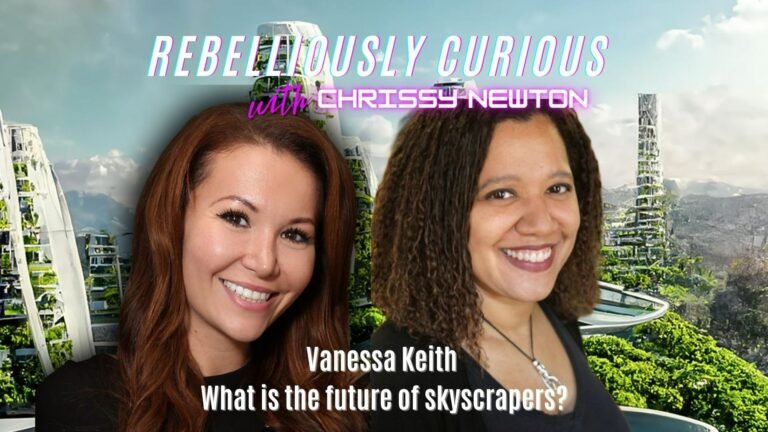“Have you ever wondered what the future of skyscrapers might be?” asks Rebelliously Curious host Chrissy Newton. “With population increasing and the global climate crisis on our heels, Vanessa Keith, principal at Studioteka, an award-winning design firm, is trying to solve those issues with architecture.”
“Studioteka approaches design through a multidisciplinary lens spanning architecture, technology, economic and social development, and urban and environmental concerns.”
In her recent interview, Newton discusses Keith’s book, 2100: A Dystopian Utopia—The City After Climate Change, which examines case studies of 14 cities around the world in the year 2100, employing emerging tech and innovative techniques designed to tackle the climate crisis.
To start, Keith talks briefly about her background and why she started the architecture firm Studioteka. Then it is off to the races, as Newton asks Keith what the ideal future office might look like.
“In terms of work,” Keith replies, “it would be a place where you can have constant learning (and) where you have people you can interface with that you are constantly learning from.”
She expands on this vision, explaining how a future workplace with a less “heavy” hierarchy will allow for the sharing and creation of new ideas.
“An intern who walks through the door might have an amazing idea,” Keith explains, “but if they don’t feel like they can express it, somebody higher up on the food chain (may not) realize they can learn something from the intern. There needs to be a kind of mutual learning. Everybody has something to contribute.”
Keith quickly shifts the discussion to her vision of future cities and how her background influenced her current approach. This involved looking not only at the urban planning aspect but at things like CO2 emissions and climate change. For example, she points out how hurricanes create a seasonal threat to places like Puerto Rico and how architecture can help solve this problem.
“Painting the roofs white and the streets white is something we could do now,” she explains, noting how even simple solutions can help combat the effects of climate change. Unfortunately, Keith says that these things are not always put into action, so as an architect, she started to take the approach of what city planning might look like if no efforts to combat climate change were implemented.
“So, what if we don’t do anything?” she asks only half-jokingly. “What if it’s like a dystopian utopia? There’s nothing to design in a world of zombie apocalypse chaos, and everyone’s killing each other.”
“That’s not really a design project that I’m interested in,” she adds with a chuckle.
This discussion soon leads to what climate scientists call a ‘four-degree world.” Keith explains how there are several components to design that would need to be taken into account in a four-degree world, including things like electronic waste recycling. The reuse of building materials will also become critical, especially in the developing world. She then talks about unused surface areas of buildings, including roofs and walls, that can be adapted to generate energy or aid wildlife habitats through relatively simple approaches.
“I do like the idea of organizing a city around transit,” Keith adds when asked by Newton about a new cutting-edge ‘horizontal skyscraper’ under development in Saudi Arabia, “so that you don’t actually need cars. I think that is really brilliant.”
When pressed by Newton to explain what types of changes our children and grandchildren might see in the future workplace, Keith talks about how the pandemic changed things in a lot of negative ways but also showed us how quickly humans can pivot to a new, futuristic approach to work.
“I have friendships with people that I have only seen on Zoom,” Keith explains. “And then, when I see them in person (for the first time), it’s like you’re seeing an old friend.”
This dynamic, including doing virtual workouts and hangouts with friends around the world, suddenly gave her a whole new insight into the idea of the workplace of the future.
“I thought to myself, ‘why did I think that place was an important thing for friendship? Why does where your body reside matter in terms of friendship?’”
Keith notes how the entire world seemingly shifted overnight, and we suddenly learned how to run our businesses and private lives in a whole new way.
“Humans are incredibly adaptive and ingenuous,” she exclaims.
At this point in the interview, Newton asks Keith about the virtual world of Meta and how she envisions virtual reality will impact the 22nd-century workplace. Keith responds by explaining how sometimes technology takes a while to evolve and how the future of virtual reality is probably way beyond just becoming a three-dimensional internet.
“(With VR) I can do so much more and be so many more places because I don’t have to drag my body around with me,” she explains. “Which can be exhausting.”
Keith says her team already uses the technology to explore three-dimensional environments allowing them to collaborate and have a shared experience like they are all in the same place. She even says they do VR happy hours in the Metaverse, offering people working remotely something usually only available after flying around the world to be together.
“I think that’s really the power of the Metaverse,” explains Keith. “The ability to really connect, and to connect with people whose bodies are maybe halfway around the world. You would think that is not a valid friendship because my body is in New York and your body is in Australia, (but that) really doesn’t matter anymore.”
“I think it will create more connection,” adds a nodding Newton. “Because instead of looking at someone on your social (media), you can interact with them socially.”
At this point in the interview, Keith and Newton begin to discuss how urban planning will take place when planning and building the cities of the 22nd century. Now seemingly in her comfort zone, Keith really gets her stride, talking about many of the things humanity will need to leave behind and the mindset changes that will be required for us to avoid extinction and instead experience a true “renaissance of humanity,” that will shape our future urban landscape.
“We are part of the planet,” she explains. “Part of the problem is, we don’t see ourselves that way.”
This mindset will need to change, she says, and is key to creating a technologically advanced future of humanity that is in step with the environment instead of one that is damning the species to a massive societal collapse.
For the balance of the interview, which is highly entertaining and packed with exciting information, Keith talks about sharing the planet, building skyscrapers in Antarctica, inventing new technologies that will change urban development and urban farming, and how future architects will meld sustainable living with advanced virtual environments to create a whole new definition of society and community.
After watching the interview, it is clear that Keith really knows her stuff, and the rhythm she and Newton generate throughout their entire discussion feels like a breath of fresh air in a 1000 ft skyscraper rooftop garden. In fact, by the end of their 58-minute journey, the viewer may even feel like they were allowed to steal a peek into Keith’s personal crystal ball, where old-world values and almost magical technology paint a picture of a brighter, healthier, and sustainable urban/suburban techno-future.
Which sounds so much better than a zombie apocalypse.
Follow and Connect with Author Christopher Plain on Twitter @plain_fiction

